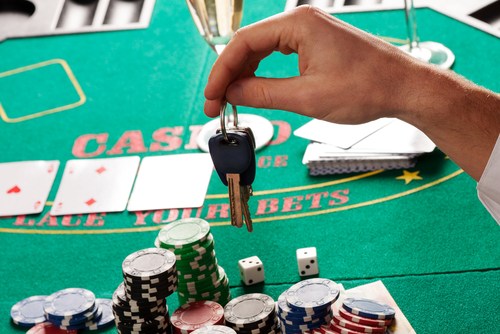Gambling Disorder
What Is Pathological Gambling?
 Photo courtesy of Medical DailyOpens in new window
Photo courtesy of Medical DailyOpens in new window
Gambling, a widespread activity around the world, involves risking something of value in the hopes of obtaining something of greater value. Most adults gamble without incurring problems. In the general population, the lifetime prevalence rate of pathological gambling is about 0.4 – 1.0% (DSM-V). |
Pathological gambling can be described as a disorder that consists of frequent, repeated episodes of gambling that dominate the patient’s life to the detriment of social, occupational, material, and family values and commitments.
Excessive gambling was first officially recognized as a psychiatric disorder in the ninth edition of the International Classification of DiseasesOpens in new window. Three years later, pathological gambling (PG) was added to USA diagnostic coding of the Diagnostic and Statistical Manual of Mental Disorders, third edition (DSM-III).
The original diagnostic criteria included in the DSM-III was based on several professors’s clinical experience at that time, which put an emphasis on damage and disruption to the individual’s family, personal or vocational pursuits, and money-related issues. In this edition, PG was classified as an impulse control disorder (‘ICD’)Opens in new window.
In the next edition, the PG criteria were revised to reflect its similarity to substance dependence, such as the addition of “repeated unsuccessful attempts to control, cut back or stop gambling” (DSM-IV).
In the DSM-IV, PG was classified under the section of “Impulse Control Disorders Not Elsewhere Classified”. As the growing scientific literature on PG reveals common elements with substance use disorders, PG was moved moved to the category “Substance-Related and Addictive Disorders” (‘SAD’) in the fifth revision of the DSM (DSM-V). Moreover, in the DSM-V, PG was renamed “gambling disorder”. Today, PG is thus the only non-substance related disorder or behavior addiction in the SAD category.
Recreational Versus Pathological Gambling
It is known that when someone is too involved with gambling, he or she is prone to pathological gambling. But where should we draw the line? Fong et al., summarized differences between a recreational gambler, and a pathological one. See two cases of gamblers: recreational versus pathological.
Gambler 1: Recreational Gambler
- Sixty-seven year-old retired physician who plays poker at the local casino 5 times per week and up to 5 h per session.
- Not increased gambling limits for the past 20 years.
- Never stayed at the casino for more than time planned.
- Allocates appropriate time for exercise and family.
- Financially comfortable with retirement account.
- Family is aware of gambling behavior.
Gambler 2: Pathological Gambler
- Twenty-year-old college student who gambles whenever he has money.
- Skips courses and assignments to gamble instead.
- Engages in bank fraud and steals from girlfriend to finance gambling.
- Has attempted to quit or reduce gambling 10 times in the last 2 years.
- Conceals gambling behavior from family and friends.
- Uses money from financial aid and scholarships to gamble.
- About to get kicked out of college for poor grades and financial status.
Compared with the first gambler, the second gambler cannot control his gambling, and experiences significant negative consequences from his gambling behavior.
How to Diagnose Pathological Gambling?
The definition of pathological gambling in the DSM-IV had been the most widely used diagnostic code for a long time.
To be diagnosed as a pathological gambler according to the DSM-IV, an individual must meet at least 5 of the 10 diagnostic criteria, and all criteria were granted equal weight. Now we have the newest diagnostic code in the DSM-V, in which one major change of clinical description of gambling disorders includes the elimination of the “illegal acts” criterion.
The rationale for this change is the low prevalence of illegal behavior among individuals with gambling disorder, and no studies have found that assessing criminal behavior helps distinguish between people with a gambling disorder and those without one.
To be diagnosed with gambling disorder according to the DSM-V, an individual must meet at least 4 of the 9 diagnostic criteria in a 12-month period. See below for the DSM-V’s diagnostic criteria of gambling disorder:
|
|
Apart from the DSM-V, screening tools such as the South Oaks Gambling Screen (SOGS). Problem Gambling Severity Index (PGSI), Lie/Bet Questionnaire, Gamblers Anonymous Twenty Questions (GA20) and the Massachusetts Gamblign Screen (MAGS) can also help with diagnosis.
The series:
- What Is Addiction (Biological Perspective)?Opens in new window
- What Is Addiction (Psychological Perspective)?Opens in new window
- Addiction and Voluntary ActionOpens in new window
- Treating Addiction and Avoiding RelapseOpens in new window
- Compulsivity and Impulsivity (as related to Addiction)Opens in new window
- What is Substance Addiction?Opens in new window
- Gambling Disorder (What Is Pathological Gambling?)Opens in new window
- What Is Food Addiction?Opens in new window
- What Is Internet Addiction?Opens in new window
- Fauth-Bühler M, Mann K, Potenza MN (2017) Pathological gambling: a review of the neurobiological evidence relevant for its classification as an addictive disorder. Addict Biol 22:885 – 897.
- Griffiths M (1996) Gambling on the internet – A brief note. J Gambl Stud 12:471 – 474.
- Shaffer HJ, Hall MN, Vander Bilt (1999) Estimating the prevalence of disordered gambling behavior in the United States and Canada: a research synthesis. Am J Public Health 89(9): 1369 – 1376.

